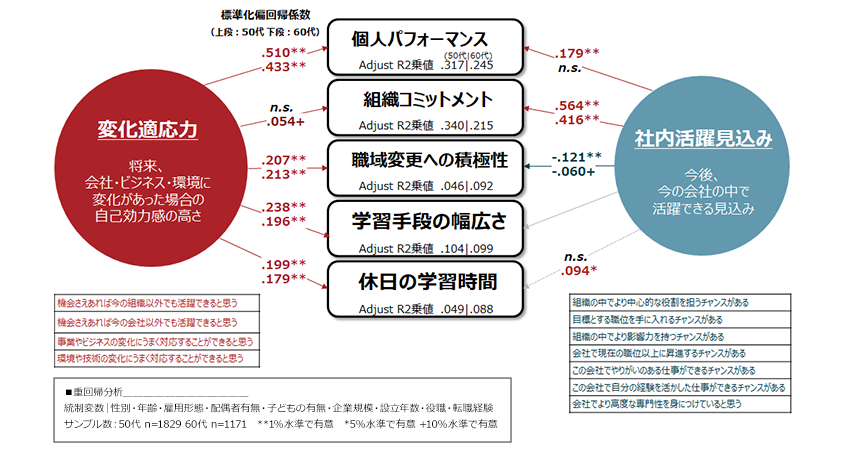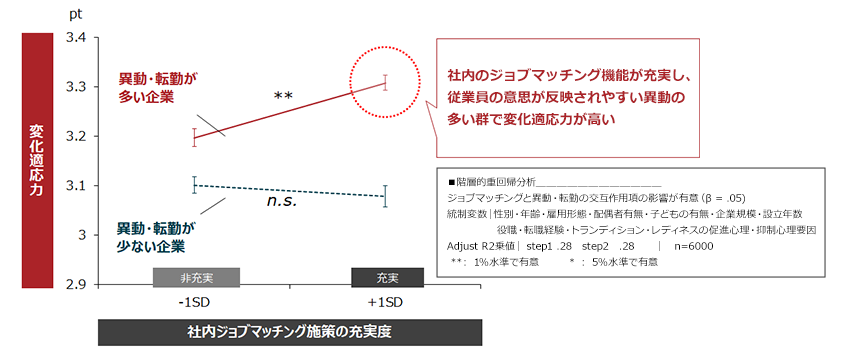Performance and rehiring of senior employees What does human resources management supporting the performance and motivation of senior workers look like?
Release Date:

※This article is a machine translation.
With the law being revised to mandate that companies endeavor to allow employees to continue working until 70 years of age, companies are required to strive even harder to facilitate the active participation of senior employees. When we looked at the reality of such participation on the part of senior employees, we discovered that more than 40 percent of companies are aware that motivation and performance levels are low, that the inactivity of senior employees has an impact on younger employees, and the reasons for the promotion of increased activity on the part of senior employees are important. Consequently, this column will explain the reality of recruitment and employment of senior employees, the expectations and challenges facing senior employees, and the characteristics of human resource management undertaken to encourage senior employees to work at high levels of performance and participate more in activities both at and outside work based on the results of our survey.
Index
- The current state of employment for senior workers
- The expectations and issues surrounding senior workers
- The inactivity of senior workers leads to young workers leaving the company
- Improve the “ability to adapt to change” of senior employees
- Strengthening the internal human resources matching function of companies will improve their “ability to adapt to change”
- Summary
The current state of employment for senior workers
From April 2021, part of the “Act on Stabilization of Employment of Older Persons” (the Act on Stabilization of Employment of Older Persons) was revised, and companies were given a “duty to make efforts to secure employment opportunities until the age of 70”. This revised law is also referred to as the “70-year-old Employment Law” or the “70-year-old Employment Security Law”, and it requires companies to take the following specific measures.
① Raise the retirement age to 70
② Abolish the retirement age system
③ Introduce a system of continuous employment (reemployment system, extended working hours system) until the age of 70
(including those by other employers in addition to specially related employers)
④ Introduction of a system for continuously concluding outsourcing contracts until the age of 70
⑤ Introduction of a system that allows employees to continuously engage in the following businesses until the age of 70
a. Social contribution businesses implemented by employers themselves
b. Social contribution projects carried out by organizations to which the employer has outsourced or invested (provided funding)
The most common response from companies was that they had a “post-retirement re-employment system” in place, with 86.1% of companies selecting this option (Figure 1).
Figure 1: Responses to the “obligation to make efforts to secure employment opportunities until the age of 70

So, what kind of work are senior workers doing after being rehired under the post-retirement rehiring system?
First of all, if we look at the change in annual income, we can see that it has fallen by an average of 44.3%
compared to before being rehired (Figure 2, left). However, 55% of rehired workers are doing “the same kind of work
as before retirement” (Figure 2, right), and we can see that annual income is falling regardless of the content of
the work. In this situation, it seems difficult to maintain a positive attitude towards work, motivation and
performance.
Figure 2: Changes in annual income and job duties of re-employed retirees

The expectations and issues surrounding senior workers
On the other hand, how do companies view the work of their senior employees (Figure 3)? The top three items in which senior employees were “meeting expectations” were “demonstrating expertise”, “passing on business partners and personal connections”, and “training junior staff”. However, even for the top items, the percentage of employees who “met expectations” was only around 30%, suggesting that there is a sense of challenge regarding the performance of senior employees. For items such as “taking on new work challenges” and “autonomous career building”, the percentage of employees who “met expectations” was below 20%.
Figure 3: Expectations for senior human resources and their current situation

Looking at the issues that companies feel they face with their senior human resources, the top three issues
were “low motivation”, “low performance” and “difficulty in management”, all of which were apparent in over 40% of
companies (Figure 4).
Figure 4: Issues that companies feel they face with their senior human resources

The inactivity of senior workers leads to young workers leaving the company
The inertia of senior employees can also have an impact on the job-hopping of younger employees. As Figure 5 shows, in workplaces where the work of senior employees is unclear or they are marginalized within the organization, the intention to change jobs among younger employees is more than 25 points higher than in workplaces where this is not the case. Companies that are facing the issue of senior employee inertia should also be aware of the repercussions.
On the other hand, further analysis revealed that the active participation of senior employees has the effect of suppressing the intention of younger employees to change jobs. The active participation of senior employees is expected to have a positive impact not only on the performance of the senior employees themselves, but also on the company as a whole.
Figure 5: Relationship between the inactivity of senior employees and the intention of younger employees to change jobs

Improve the “ability to adapt to change” of senior employees
So, what is important for revitalizing senior employees? The key is “change adaptability” (transition readiness). Here, change adaptability is treated as a sense of self-efficacy that enables people to respond well even when there are changes in the company, business, or environment.
High change adaptability promotes work performance, a positive attitude towards changing job roles, and a positive attitude towards learning (Figure 6, left). This can be seen as a state where, in addition to performing well in their current job, they are also proactively continuing to improve themselves, and if necessary, are also proactive about changing jobs to a position that requires new skills and knowledge. In this state, if, due to changes in the business situation, etc., they feel that they could fully demonstrate their abilities at another company rather than their own, they would see the possibility of being hired if they tried to change jobs.
What we want to compare with change adaptability is the prospect of being able to continue to play an active role within the company (the “prospect of being able to play an active role within the company”) (Figure 6: right side). The prospect of being able to play an active role within the company has a strong influence on organizational commitment, but its strength of influence on work performance is not as strong as change adaptability. It also has a restraining effect on “willingness to change job”, and there is a high risk, for example, that employees will cling to their old jobs even after being re-employed after retirement.
Figure 6: The impact of “change adaptability” and “prospects for success within the company” on performance, etc.

Next, let’s look at the impact of change adaptability and prospects for success within the company on the
demonstration of work performance by age group (Figure 7). As people get older, the impact of change adaptability on
work performance increases, but the impact of internal activity prospects tends to decrease. In order to get
employees of all ages to perform at a high level, it is necessary to have them acquire change adaptability, which is
a skill that can be used not only in their own company but also in other companies.
Figure 7: The degree of influence of “change adaptability” and “prospects for success within the company” on performance

Strengthening the internal human resources matching function of companies will improve their “ability to adapt to change”
So, what are the characteristics of human resources management in companies with senior employees with high change adaptability? The key lies in strengthening the internal human resources matching function.
The analysis showed that companies with employees with high change adaptability have a good range of internal job matching measures, such as internal job posting, internal FA systems that allow employees to promote themselves to the departments they want to work in, and internal second jobs, and also have a high level of transfers and job rotations (Figure 8). In other words, it is important to create an environment where transfers and job rotations, which reflect the intentions of the employees themselves, are actively carried out. It is also important to note that even if a company has a well-developed internal job matching system, if it is not used and there are few transfers and job rotations, then employees’ ability to adapt to change will be relatively low.
Figure 8: Characteristics of HR management that improve change adaptability

In order to strengthen the internal human resources matching function of a company, it is necessary to have a system in place that allows employees to be informed of any surplus or shortage of positions in the company, based on a thorough inventory of the types of jobs and positions needed in each business division. In addition, by clearly stating what skills and experience are required for these positions, it is possible to expect not only internal matching, but also the effect of encouraging employees to plan their medium-term career development. By clearly stating career paths and linking them to career paths, it is possible to expect further effects by providing opportunities (such as internal second jobs and job rotations) that allow employees to proactively fill in any missing skills and experience of their own volition, as well as by providing learning support.
Summary
Companies recognize that senior employees are meeting expectations in terms of “demonstrating expertise”, “passing on business partners and personal connections”, and “training junior staff”, but only around 30% of companies feel this is the case. On the other hand, more than 40% of companies feel that there are issues with low “motivation” and “performance”. Furthermore, it was revealed that the inertia of senior employees is increasing the intention of younger employees to change jobs. From this, we can see the importance of human resource management that supports the activities of senior employees.
The key to getting senior employees to play an active role is for them to acquire the ability to adapt to change, which has a positive impact on their work performance. In order to improve this ability to adapt to change, it is important to strengthen the company’s internal human resources matching function. In addition, it is important to create and operate a system that allows employees to transfer or be transferred at their own discretion, such as by clarifying internal company posts, internal recruitment, free agent systems, and internal side jobs.
From the perspective of the careers of senior employees, it is difficult to solve the problem of inertia by implementing stopgap measures just before and after re-employment after retirement. From the late 40s and early 50s, it is important to create opportunities and environments where employees can face their own careers after re-employment, by learning about what positions are available within the company and what kind of preparation is needed to take up those positions opportunities and environments that allow them to prepare for these positions and to think about their own career after re-employment are the kind of human resource management that leads to high performance and motivation for challenging work after re-employment for senior personnel.
In this column, we have focused on the systems and operational aspects that form the foundation for revitalizing senior employees, but in the following column, we will focus on the “five behavioral characteristics” of active senior employees. We hope you will find this useful as an approach to the individual.
Column: “Five Behavioral Characteristics Common to
Middle-Aged and Senior Workers Who Are Making Strides”
※It will be translated into English at a later date.
THEME
注目のテーマ
CONTACT US
お問い合わせ
こちらのフォームからお問い合わせいただけます